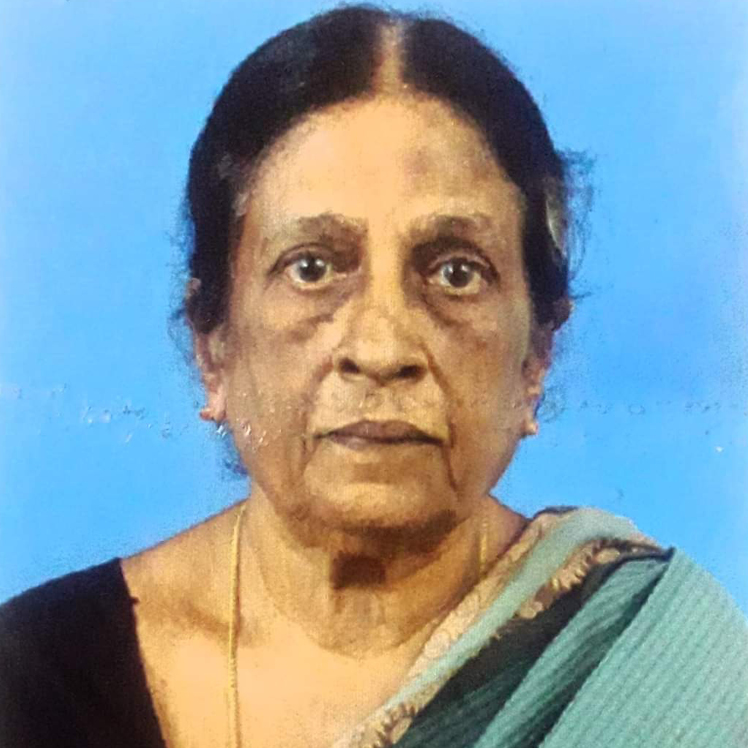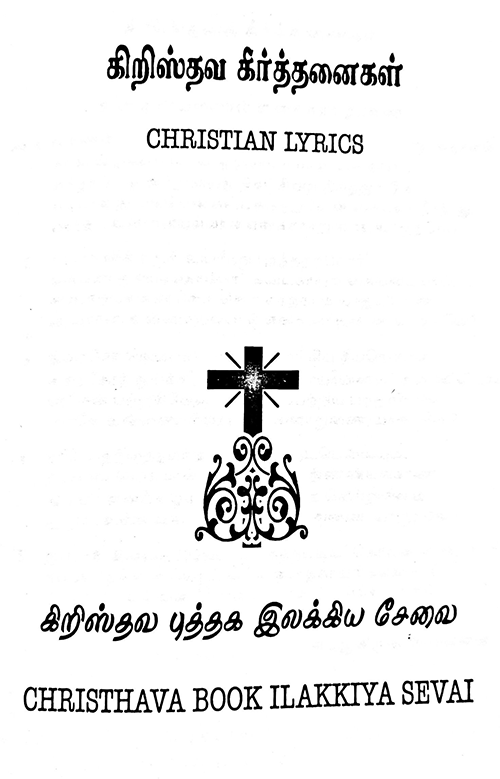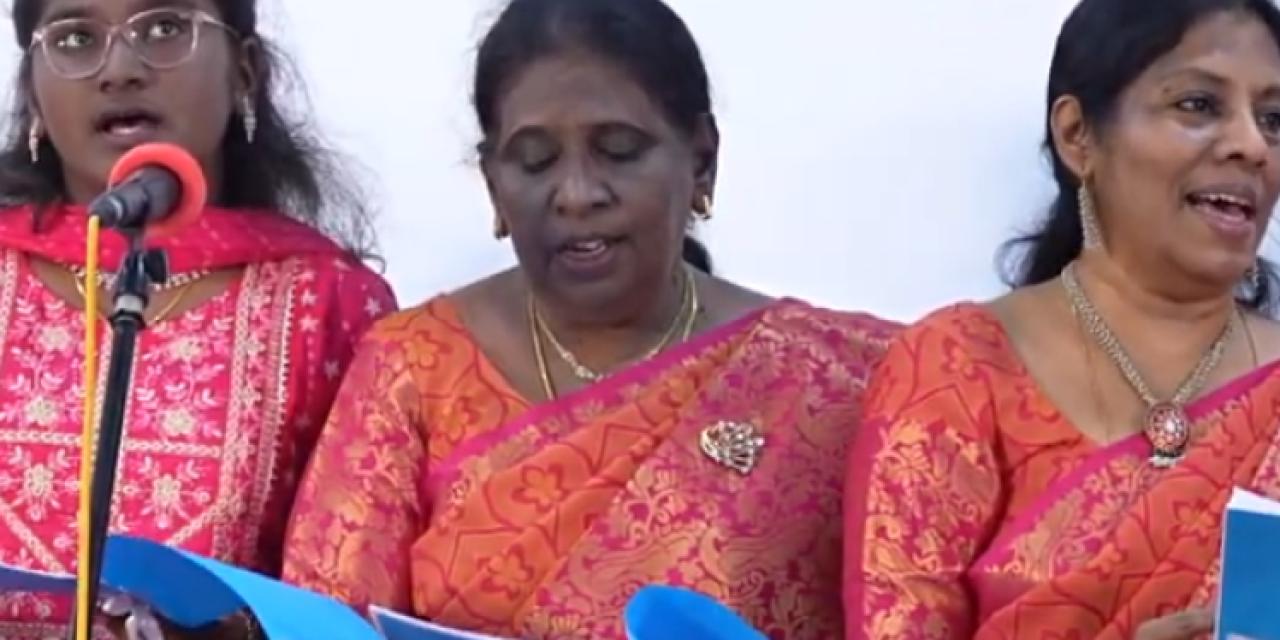Each morning throughout South India, people hear music coming from Hindu temples. Chanting God’s name and fame is one of the nine ways Hinduism prescribes to connect with God personally and congregationally. This praise and devotion genre is part of the ancient classical music variously called Carnatic, Karnatik, or Karnataka music. The songs themselves are known as keerthanai, keerthan, and kirttanai.
Between the late 1700s and early 1800s, Protestant missionaries realized that rewriting keerthanais with Christian lyrics or composing new Christian keerthanais could attract people to and teach people about the gospel. Missionaries included keerthanais in songbooks along with translated Western hymns, but gradually used keerthanai more for evangelization than for corporate worship. Indian Christians still sing them at weddings and in homes, and sometimes in corporate worship.
“Tamil is a rich language, one of the world’s oldest classical languages that is still spoken,” says artist Susheila Williams. “Christian Carnatic music is heavenly. When we sing these keerthanais in our language, we are emotionally touched. Christians have also composed these devotional songs in the Telugu, Malayalam, Marathi, and Kannada languages.” Williams has a bachelor’s degree in economics, a master’s in English literature, a doctorate in women’s studies, and various diplomas, and she has worked as an interior designer and a visual artist.
The Church of South India appointed Williams to help with the 1995 founding of CSI Bishop Appasamy College of Arts & Science (BACAS) and the 2012 founding of CSI Bishop Appasamy College of Education—both in Coimbatore, Tamil Nadu, India’s southernmost state. In 2010, she formed a group that hired a classically trained teacher to help them learn Tamil-language Christian keerthanais sung to traditional ragas (seven-pitch musical frameworks) and talas (rhythmic patterns).
Since retiring as the BACAS’s chief administrative leader, Williams has dedicated herself to reviving classical Christian keerthanais accompanied by traditional instruments. In 2010 she formed the group Manamahizh Keerthanai Kuzhu to learn and perform keerthanais. “Our group works to create awareness of keerthanais to all the Tamil-speaking sections of Christian society and all age groups,” Williams says. “Our aim is to bring back keerthanais to their original status in the worship service.” The group’s name roughly translates to “Sweet Joy and Happiness Keerthanai Group.”
An Indian way to express devotion

The Samaveda, the ancient Hindu scripture of sacred chants and melodies, was written in the early Iron Age around the same time that biblical Israel experienced the last of its judges and the first of its kings. Hindus throughout India saw music as a gift from the gods. Between the times of the Crusades and the Protestant Reformation, Indian classical music evolved into distinct styles. In the north, Hindustani music reflected Persian and Islamic influences and emphasized improvisation. In the south, Carnatic music developed more ragas and emphasized precision in performing structured compositions.
One of Susheila Williams’s many favorite Christian keerthanais is “Ethanai Naaval Thuthipen / How Many Tongues,” song #92 in Christhava Book Ilakkayi Sevai, the ecumenical Tamil Christian keerthanais collection. When speaking English, Tamil Christians often refer to keerthanais as “lyrics.”
She explains that “How Many Tongues” follows a classic structure laid down by Purandara Dasa, a fifteenth-century Hindu monk who lived in present-day Karnataka, India. “He systematized the method of teaching Carnatic music, which is followed to the present day,” Williams says.
The song begins with a first refrain (pallavi) followed by a second refrain (anupallavi), and then it moves to short verses (saranam). Williams translates this lively, joyful keerthanais:
Pallavi: O Lord, how many tongues will I need to praise you and sing of your love and kindness to me, my Lord.
Anupallavi: As I keep pondering over all that you have done for me, my heart melts and is filled with joy to garland you with praises and exalt you.
Saranam 1: Only those who believe will understand your wonderful loving heart and the miraculous ways in which you lead us and bless us with wholesome rich blessings, O my Creator.
Saranam 2: O mighty God, benevolent King, who listens to our prayers and supplications, pardon the weakness of lowly beings. You wipe away all the burdens and worries of all those who surrender and submit themselves at your beautiful feet, and you take them into your arms with loving care.
Saranam 3: O my heart, remember all the good things God has done for you and be always ready and eager to worship him. The grace of God cannot be measured. Be brave and go with all your might and strength to serve your loving heavenly Father.
This anupallavi—and many keerthanai texts—uses the word “garland” because fragrant flower garlands symbolize love, purity, devotion, and respect in Indian weddings and worship.
Williams is a lifetime member of Keerthanaiin Mahimai Trust, formed in 2008 to popularize singing keerthanais with traditional instruments “among the present-day generation.” The eleventh annual KMT concert began with “Ethanai Naaval Thuthipen.” The instrumentalists—playing veena, tabla, flute, finger cymbals, and harmonium—introduced the ragam (prescribed ascending and descending scales) and talam (the beat) before the vocalists began.
Christian contributions to Carnatic music
Wiliams says that earlier Carnatic music was “monopolized by the Brahmin community,” high-caste Hindus who supported non-Brahmin poets and musicians. “Christian poets and musicians like Vedanayagam Sastriar, Henry Alfred Krishnapillai, Rev. N. Samuel of Tranquebar, Abraham Pandithar, and others wrote keerthanais and contributed to Carnatic music and scholarship,” she adds. Carnatic music experts have noted many ways that Hindu and Christian musicians borrowed from each other’s tunes, followed each other’s lyrical models, and collaborated in teaching Carnatic music.
Vedanayagam Sastriar (1774–1864), son of a Hindu convert to Catholicism, was tutored by a German Lutheran missionary along with Prince Serfoji. When the prince became raja (king) of Tanjore, he invited Sastriar to become his court poet. Sastriar introduced many Tamil phrases describing God’s greatness and wrote more than five hundred Christian keerthanais set to traditional ragas and talas. Christians today still sing his “Aamen Alleluyah,” which his descendants have adapted to include both traditional and modern instruments.
Ethnomusicologist Zoe Sherinian is a leading scholar on Tamil Christian musics. She explains that in 1853, Edward Webb, an American Congregational missionary, published more than a hundred of Sastriar’s keerthanais in Christian Lyrics for Public and Social Worship. Sastriar taught the songs to Webb and eight Indian catechists, who then transmitted them orally throughout the towns and villages with Protestant missions. Most Protestant missionaries taught that true Christianity is anti-slavery and anti-caste, so they didn’t limit their song teaching to upper castes.
Hindu poet Henry Alfred Krishnapillai (1827–1900) converted after being appointed by Bishop Robert Caldwell (1814–1891) to teach Tamil. His use of Hindu analogies in Christian keerthanais showed people they didn’t have to abandon their culture to follow Christ. Lutheran pastor N. Samuel of Tranquebar (1850–1927) was also a poet, an author, and the first Indian professor at an ecumenical seminary in South India. Abraham Pandithar (1859–1919) was a native medicine practitioner, agricultural pioneer, and musicologist who wrote the definitive two-volume set on ancient music systems in South India, especially Tamil music and literature. He also founded the All-India Music Conferences on Carnatic music theory and practice.
Williams says, “My grandparents’ generation showed keen interest in singing keerthanais. Early missionaries like Bishop Caldwell and Bishop J. E. Lesslie Newbigin (1909–98) patronized and promoted the singing of keerthanais in the churches. My native place is Madurai [the cultural capital of Tamil Nadu], where my father was in government service. I was ten years old when India became independent in 1947. In the evening family prayer, my mother always encouraged us to sing one keerthanai and one hymn.
“After marriage, my family lived in Northern India. We longed to sing and worship God by singing keerthanais. After fifteen years, when we came back to Tamil Nadu, this passion continued and continues now also.”

Indigenous evangelism
Christian keerthanais appealed to educated people, in part because the genre is built on classical Tamil metaphors and music systems. Learning Christian keerthanais helped illiterate people of several languages learn Bible stories and theology. It gave them imagination to see themselves as made in God’s image rather than as born into lower or even “untouchable” castes from which they could never escape.
Two keerthanais popular during the Christmas season illustrate how the music helped Tamil people internalize biblical content. The first refrain of #34, “Arasanai Kanamal Irupano / Song of the Magi,” as translated by keerthanai group member Sylvia Prince, asks, “Shall we refrain from seeing the King? / Shall we not spend our lifetime in vain / if we do not see the King?” The first verse, based on Numbers 24:17, is “The prophecy of prophet Balaam that / ‘A star shall dawn in Jacob and / a scepter out of Israel’ is a blessing come true.”
The second of five verses urges, “Behold, a star arises and / leads us towards the west. / Let’s worship him with our offering / and hasten to fall at his golden feet” (emphasis added). The final verse exhorts singers to “worship the golden anklets of the King” (emphasis added).The author, G. S. Vedanayagam, was a pastor who was part of a 1922 South India United Church project to create a new keerthanais book.
Vedanayagam often expressed his desire to unite with Jesus by using an image from the Shaiva branch of Hinduism—that of devotees settling their heads under the feet of their teacher till they vanish and become one with him. That’s according to seminary professor T. Dayanandan Francis in Christian Poets and Tamil Culture, published in 1978 by the University of Madras philosophy department. Abraham Pandithar wrote #35, “Kanden En Kan Kulira / I Saw the King,” based on the Luke 2:28–30 story of Simeon holding the infant Jesus in the temple. “Luke tells us that Simeon was filled with joy, and he praised God and thanked him for the wonderful blessing God had given him to see the glory of God,” explains Mrinalini David, the keerthanai group member who translated this song into English.
The song’s penultimate verse is: “He is the Savior of all those who believe him, the loving God of the poor shepherds and the rich wise men from different directions who came searching for him and worshiped him.”
The changing use of keerthanais in church worship
“People still sing the original keerthanai texts,” Williams says, “but the same lyrics often sound very different. Our music master says that many keerthanais can be sung to more than one raga. Also, there are now different styles and instruments used for keerthanais.”
In her oft-cited “Musical Style and the Changing Identities of Tamil Christians,” Zoe Sherinian describes how missionaries from various denominations and countries focused their work in different geographic rural or urban areas and among specific castes, subcastes, or outcastes. Sherinian also traces how Western, folk, and light (e.g., pop or film) styles influenced keerthanais and church worship.
Protestant missionaries found keerthanais useful for evangelization, weddings, funerals, and house blessings. But missionaries also introduced into church worship components of their own Western music culture, such as the organ, four-part harmony, and scales that followed very different note patterns from those of classical Indian raga modes.
In many rural congregations too poor to afford an organ, keerthanais remain the dominant genre in worship. Some rural churches still sing the original ragas and have retained the classic Carnatic microtones—pitches that fall between the notes produced by a piano or organ. Others have recomposed keerthanais into their own village folk styles of music and dance. Sherinian says this inculturation helps them express “aspirations for upward mobility and civil rights.”
During British colonialism, Methodists and Congregationalists encouraged the use of indigenous keerthanais for almost a hundred years. British Anglican missionaries, however, often conflated Christian identity and British identity.
“The Anglicans understood Christianizing and civilizing as a single package of language, music, liturgy, and Western values,” Sherinian explains. Anglicans often replaced indigenous keerthanais with Westernized hymns and banned traditional instruments and flower garlands as “heathen.” Yet many Tamil Christians enthusiastically learned English and adopted British cultural values because it helped them access higher education and professional jobs.
When India gained independence from Britain and the ecumenical Church of South India (CSI) formed in 1947, Indian Anglicans prevailed. Meanwhile, Sherinian notes that keerthanais adapted to reflect the layering of film styles are still popular in Pentecostal, independent, and some CSI evangelistic and youth events.
“In our Sunday services now,” Williams laments, “singing Western-style keerthanais is part of worship. The only thing is they confine this to only one keerthanai, often during offertory. The rest of the worship music is translations of English hymns. That is why we have this keerthanai ministry.”
Keerthanais revival
Manamahizh Keerthanai Kuzhu gathers every Monday evening to learn from their music master, Sivalaya Ramalingam, a Hindu with a doctorate in Carnatic music. “He helps us learn the raga and tala specified by the keerthanai writer in the book,” Williams says.
In 2016 the group began receiving invitations to sing throughout South India in Baptist, CSI, Lutheran, Methodist, and Pentecostal churches in urban and rural areas and occasionally in tribal areas. At their concerts, a mrindangam drummer maintains the tala while a violinist accompanies the raga. A Lutheran church in Kuala Lumpur, Malaysia, invited the group to sing in 2018. Sri Lankan churches invited them to sing in March 2023.
“Our aim is to create awareness of keerthanais (among) all the age groups and sections of Christian society,” Williams says. “Normally churches give us thirty to forty minutes in the middle of the worship service. Sometimes we are asked to give the message also. When we sing, we mention the keerthanai’s name, raga, and tala; the poet’s name; and the number in the keerthanai book. Congregation members sometimes sing along with us. They have started really appreciating and really enjoying these songs. We plan to extend this learning to Tamil-speaking churches in Sri Lanka, Singapore, and Malaysia.”
Many keerthanais the group sings are based on Adi tala, an eight-beat cycle common in Carnatic music. Keerthanai #347, “Inta Puvi Meetka / Restore the Earth,” uses Adi tala and Kapi raga. This common raga is usually sung at slow or medium speed and is traditionally thought to invoke devotion through pathos or joy. Group members Eva Ravi Kumar and Sumathy Jayaraj translated the song, which begins and ends with “It’s our hearts alone that belong to the Almighty, who came to restore the earth.”
Participating in Manamahizh Keerthanai Kuzhu is not the only way that Susheila Williams hopes to restore indigenous keerthanais to church worship. She and some group members participate in Keerthanaiin Mahimai Trust, which involves children, youth, men, and women in lessons, singing competitions, and an annual concert.
“I thank God for giving me an opportunity to pursue the interests I have,” Williams says. “I also thank my family members for their encouragement and consistent support!”
Learn More
Keerthanaiin Mahimai Trust helps Christians learn to sing Christian keerthanais with traditional Tamil instruments. Its articles profile keerthanai lyricists and history.
Read more of Vedanayagam Sastriar’s keerthanai lyrics on the Sastriars website created by his descendants.
Learn more about Abraham Pandithar. Descendants of Pandithar’s musical grandson Kalamamani D. A. Thanapandian created the Thanapandian website to preserve and adapt their generations-long Christian keerthanai heritage. Listen to their popular versions of Pandithar’s wedding keerthanais “Sree Ma Deva” and “Laali Padaal. ”
This Tamil Christian Carnatic music post by Tamil literature and music professor Amutha Pandian argues that Christian keerthanais should be included in music academy curriculums. Explore Carnatic music theory and current news on Darbar.
Ethnomusicologist Zoe Sherinian’s work on music and Tamil-speaking Christians includes
academic journal articles such as “Musical Style and the Changing Identities of Tamil Christians,” the book Tamil Folk Music as Dalit Liberation Theology, and documentaries such as Sakthi Vibrations.
In the journals Mission Frontiers and Ethnodoxology, Jacob Joseph argues, “Before attempting indigenization in missions outreach, the church’s worship must become indigenized.” This includes restoring keerthanais to corporate worship. Joseph founded a diploma program in worship and music at New Theological College in Dehradun (North India) and now teaches music at the South Asia Institute of Advanced Christian Studies, an institute for postgraduate theological studies and research in Bangalore, South India’s largest city.
Tamil is such an old language that biblical Hebrew borrowed many of its words. Tamil Christians played a role in Indian independence. Pew Foundation surveys yield key facts about Hindus and Christians in India and the role caste continues to play. So-called “untouchables” were looked down on for touching the cattle carcasses necessary to make double-headed mridangam drums. Yet the drums were vital to Carnatic music, Christian keerthanais, and upper-caste funerals. Some Dalit Christians are legendary mrindangam makers.

